Many UK transistors and diodes, including early types whose manufacturer is identifiable by their unique shape, can be found, usually unbranded, bearing a part number CVnnnnn. These are UK inter-service military-specification devices, the prefix CV being an abbreviation of 'common valve' ('thermionic valve' being British for what the Americans call a 'vacuum tube'). This designation was introduced in 1941 before the transistor had been invented and the series contains both vacuum and solid-state devices. It runs from CV1 to about CV12000 (!).
Each particular CV number is stated as having one or more 'prototype or possible substitutes', which are usually commercial device part numbers. Thus one CV type may be made by several manufacturers and I have found that sometimes a type may also be made by a manufacturer not listed in the Register entry for that CV device. I suspect that most CV types were normal commercial devices, possibly with tighter parameter selection. If anyone knows more details of this, please
There is good information on the Web about the CV series in general, because of the large number of valve/tube enthusiasts who share information about it. A CV semiconductor device usually (but not always) bears the markings:
- The part number CVn, where n is a three, four, or five digit number.
- A 'K' that means that it has been manufactured to specification,
- a 'B' that indicates that approval was given by UK authorities,
- a one-, two- or three-letter factory code that also identifies the manufacturer, and
- a two-letter date code.
I have some information from the CV registers in 1944 and 1946 (which contain only a few early semiconductor diodes) but the definitive source of data for CV semiconductors is the CV register of 1963, which was printed in numerous Amendments. It is downloadable from several sites on the Web but a nice breakdown is given on the page of The Wireless-Set-No19 Group of the Royal Signals.
Because of the unusual nature of the series, there is little structure to its numbering, although there are some small groups of semiconductor devices that correspond to parts of a series from the same manufacturer. Other oddities include:
- I suspect the series is largely but not wholly chronological. It seems likely that gaps were left, some of which were filled in later.
- It is common for a CV type to specify one or more other CV types amongst its 'prototypes and possible substitutes'. In some cases, only CV types are given. This may result in circular CV references with no apparent commercial prototype.
- Each CV type has a short description. For semiconductor diodes this is not very consistent. Many low-numbered diodes are described as a 'crystal', higher-numbered ones are mainly a 'semiconductor diode' but sometimes a 'semiconductor rectifier'. Other values are used, albeit rarely.
- For reasons unknown to me, a large number of American diodes and transistors are included.
- Some types are 'Cancelled'. I don't know what that signifies. Others are 'Superseded' by another CV number.
- For some types the 'prototypes and possible substitutes' field just contains a Ferranti drawing number.
- There are quite a few types described as some kind of semiconductor for which the prototype has a part number unknown to me.
- There are quite a few types for which the prototype is a VX series device. I can find no information on this series, but I suspect that it was originally a valve experimental series. In fact, VX semiconductors are hard to find.
- Manufacturer codes can be found that are not listed in the Joint Service Specifiation K.1001. These are not obscure manufacturers: a common one is NTN which appears to be Newmarket Transistors (listed in K.1001 as CO) and another is FRD which is Ferranti (listed in K.1001 as four sites: R, RA, RB, RC). I have others that I cannot identify. I'm unaware of a later manufacturer list that may explain these.
Contemporary semiconductor manufacturers' literature often contains lists of their CV types, and this often specifies equivalences that are different from, or additional to, those in the CV Register.
Obviously I do not possess all the thousands of semiconductor devices in the CV series, in fact I am seeking many of them. It is noted in the text where I am seeking examples of any particular type: if you have some for sale or exchange, please
It's hard to know how to show this enormous series. The lowest-numbered semiconductor is CV101, and the lowest-numbered transistor is CV2389.
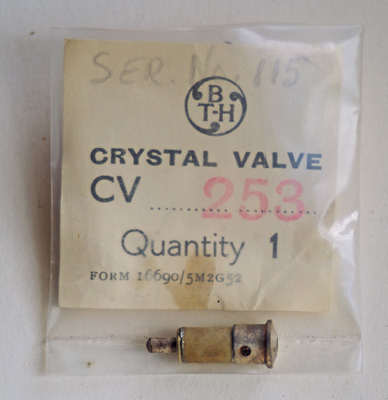
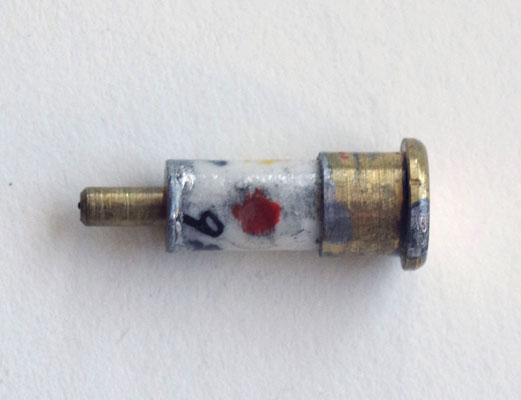
The oldest semiconductors in the series are microwave diodes, mostly silicon, some of which were used in radar equipment during World War 2. These were made by either BTH or GEC.
The 1944 and 1946 CV Registers are in two parts, A and B. Part A covers CV1 to CV290 (with some gaps) and lists each type with a single prototype and a short description. Part B covers higher numbered types and is less informative.
The 1944 Part A contains the following semiconductors:
- CV101 to CV103 are described as crystal valves with no prototypes.
- CV111 to CV113 are described as crystal valves with no prototypes.
- CV241 is described as a crystal valve 'For wavemeters'.
- CV246 is described as a crystal valve 'Detector version of CV111'.
- CV247 is described as a crystal valve 'Detector version of CV112'.
- CV253 is described as a crystal valve 'CV111 selected'.
The diode on the immediate right is a CV102 but it only bears a red dot and a handwritten serial(?) number. The CV253 shown has the part number engraved on the metal.
The 1963 Register is more informative and allows multiple prototypes 'or possible substitutes'. It exists with various 'amendments' which do change some of the details of semiconductors. It has a larger number of 'crystals', the following are those below CV1000 that are described as crystals in early amendments and I believe to be microwave types:
- CV101 to CV103 are described as crystals, and CV101 has prototype/substitute CV102.
- CV111 to CV113 are described as crystals, and CV111 has prototype/substitute CV253.
- CV162 is described as a crystal and has prototype/substitute 52094, which is unknown to me.
- CV165 is described as a crystal and has prototype/substitute CS36-A.
- CV226 is described as a crystal but has no prototype/substitute.
- CV241 is described as a crystal but has no prototype/substitute.
- CV246 and CV247 are described as crystals but have no prototype/substitute
- CV253 is described as a crystal and has prototypes/substitutes CS3-A (a BTH microwave diode) and CV111.
- CV291 is described as a crystal and has prototype/substitute CV291(BTH), whatever that means!
- CV351 is described as a crystal and has prototype/substitute CV1055 which seems to be an error as that is a valve.
- CV364 is described as a crystal and has prototype/substitute CV291.
- CV367 is described as a crystal and has prototypes/substitutes 1N21B (an American microwave diode), CS2-A, CS37-A and CV3923.
- CV727 is described as a 'crystal valve' and has prototypes/substitutes 1N21, 1N21B (American microwave diodes) and CV367.
- CV749 is described as a 'crystal valve' and has prototype/substitute 1N23A (an American microwave diode).
A few of these are sometimes for sale on eBay but old microwave diodes command quite high prices as apparently some people still use them.
Apart from the above, there are few semiconductors below CV2000:
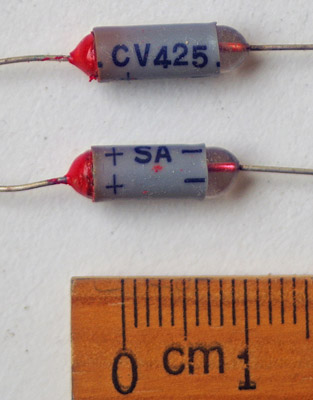
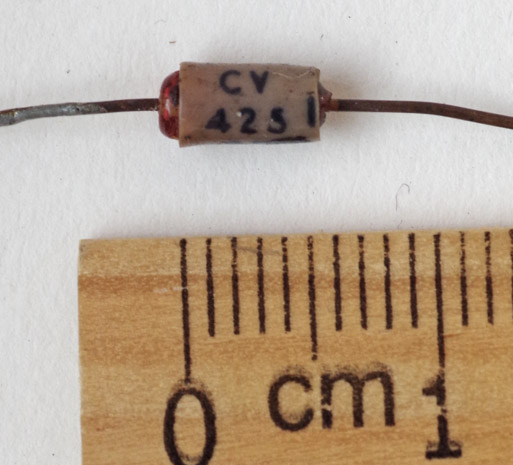
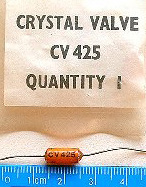
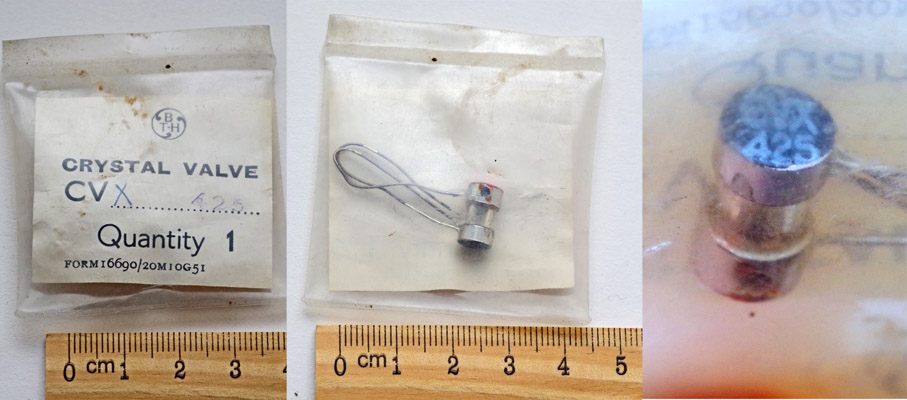
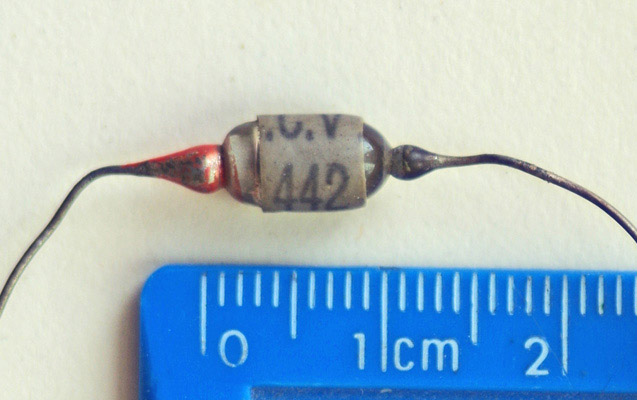
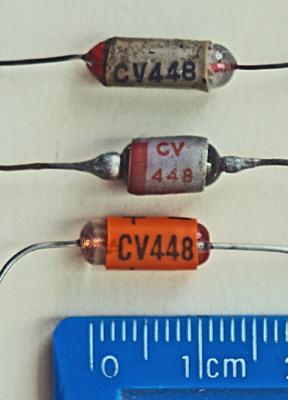
Between CV2001 and CV5000 there are remarkably few interesting semiconductors:
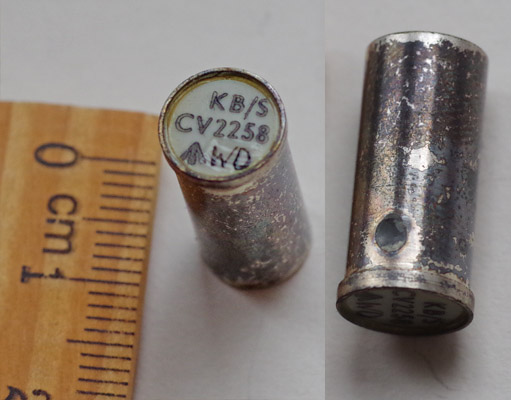
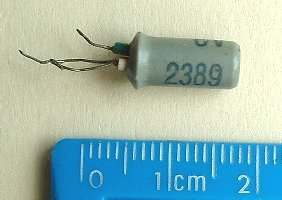
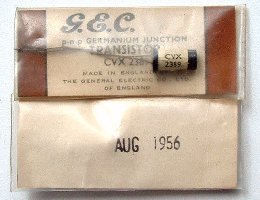
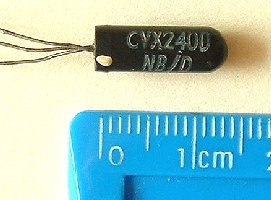
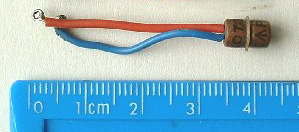
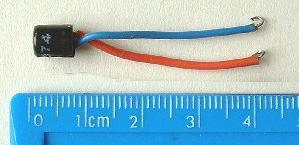
Things become rather problematic for this page now, as the CV5nnn block contains hundreds of semiconductor devices, and there are even more with higher numbers. The best I can do is to list those of interest to me, primarily UK germanium transistors, in blocks by prototype manufacturer. The dominance of Mullard is obvious. This block includes silicon transistors from several manufacturers.
My images include CV5874 made by GEC, although the Register just gives a Ferranti drawing number as prototype. The same image also shows a GEC CV5878 for which the register lists a number I don't understand but also says 'see CV7327', which has prototype GET102.
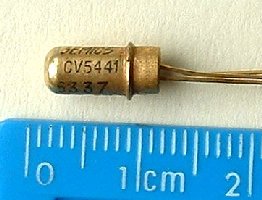
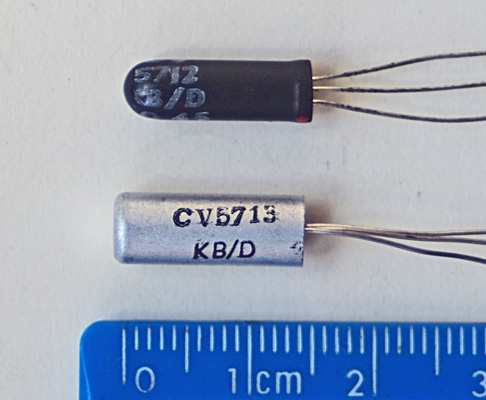
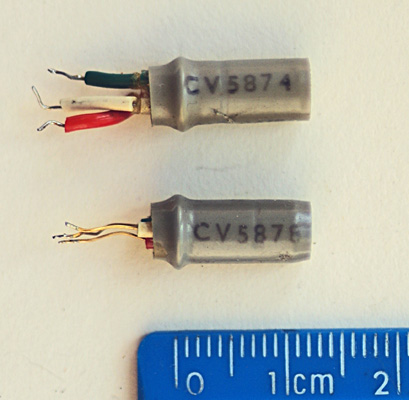
I've seen it written, and it seems to be true, that it was decided at this point to split the series: the CV7nnn block would be semiconductor devices and the CV6nnn block would be everything else. Certainly there are no semiconductors in the CV6nnn block, which only extends as far as CV6234. The CV7nnn block is all semiconductors and goes as far as about CV7875, although the Register is confusing for higher-numbered CV78nn types, and there is a block of apparently unused numbers at the end. The split was not continued and CV8nnn, CV9nnn and CV10nnn types are a mix of semiconductors and thermionic/other devices.
The CV7nnn block is enormous so I cannot even list them all. It is by far the most common number range, for instance an eBay search returns almost only CV7nnn types. I shall refer only to those that are particularly interesting. The block starts with CV7001 (there are in fact no types numbered CVn000 in the entire series), and the first types are all low-power germanium PNP from the big three UK manufacturers: Mullard, GEC and STC.
CV7001
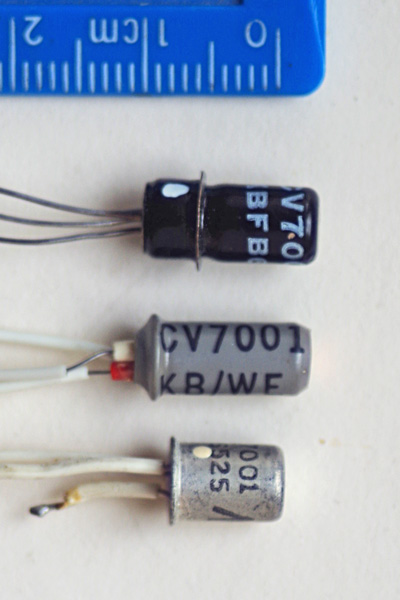
CV7002
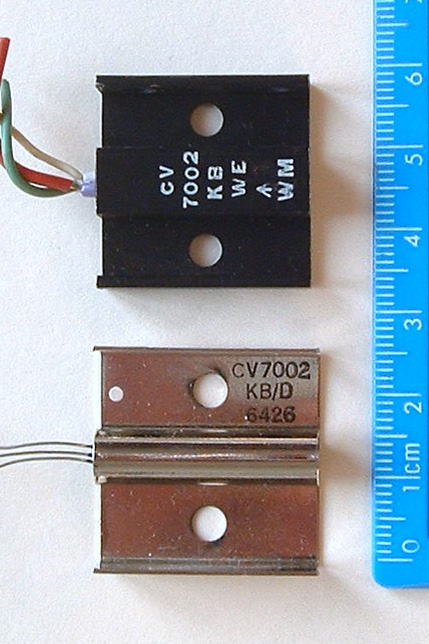
CV7003
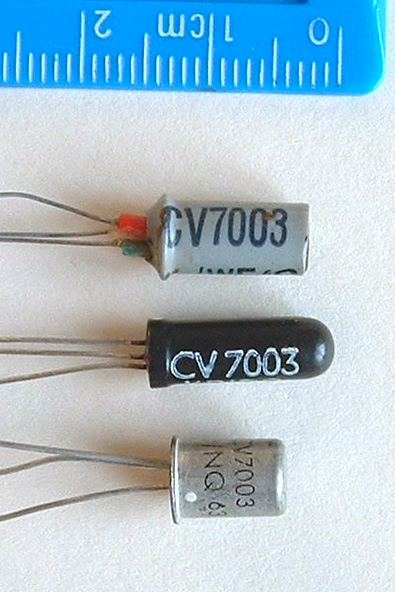
CV7004
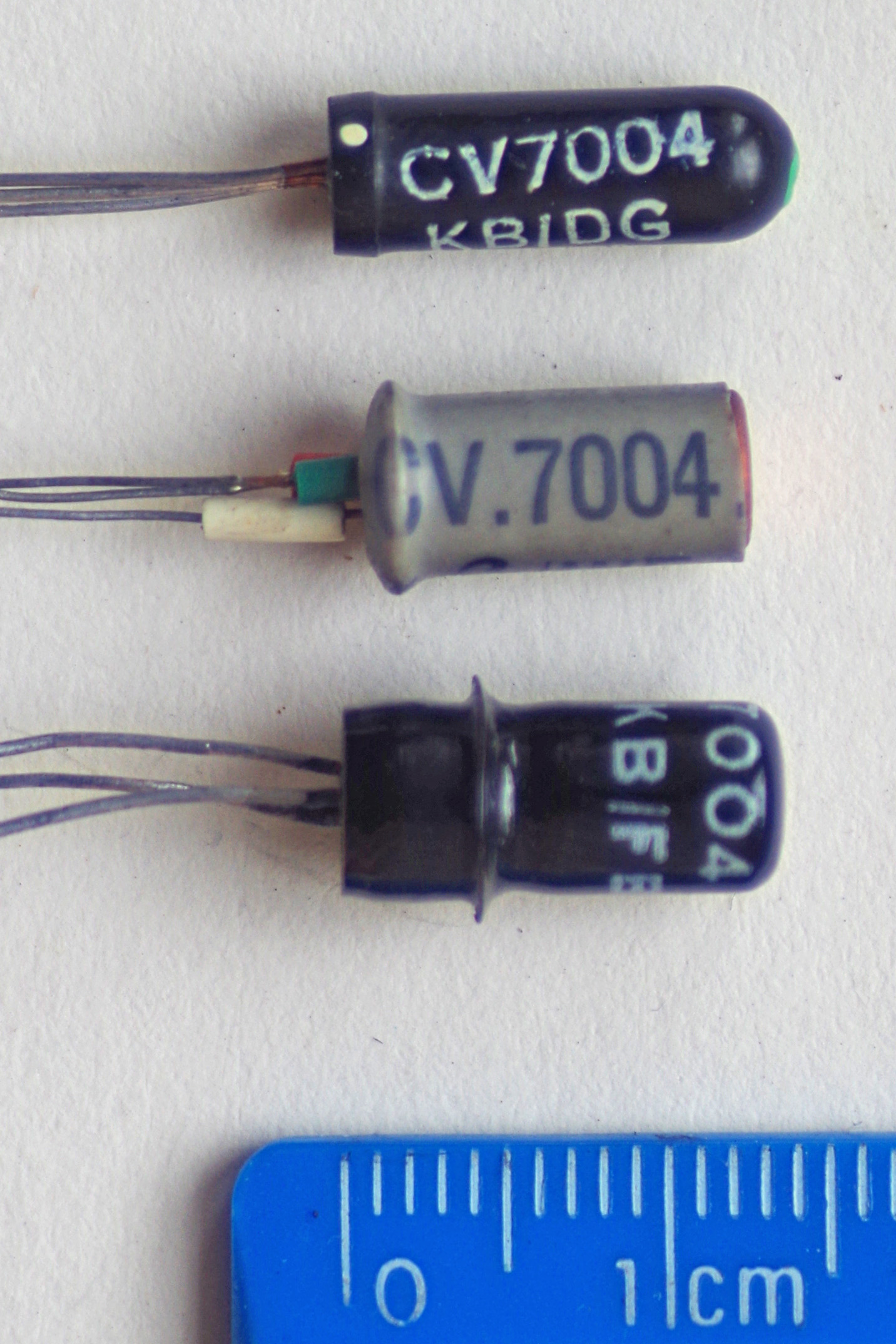
CV7005
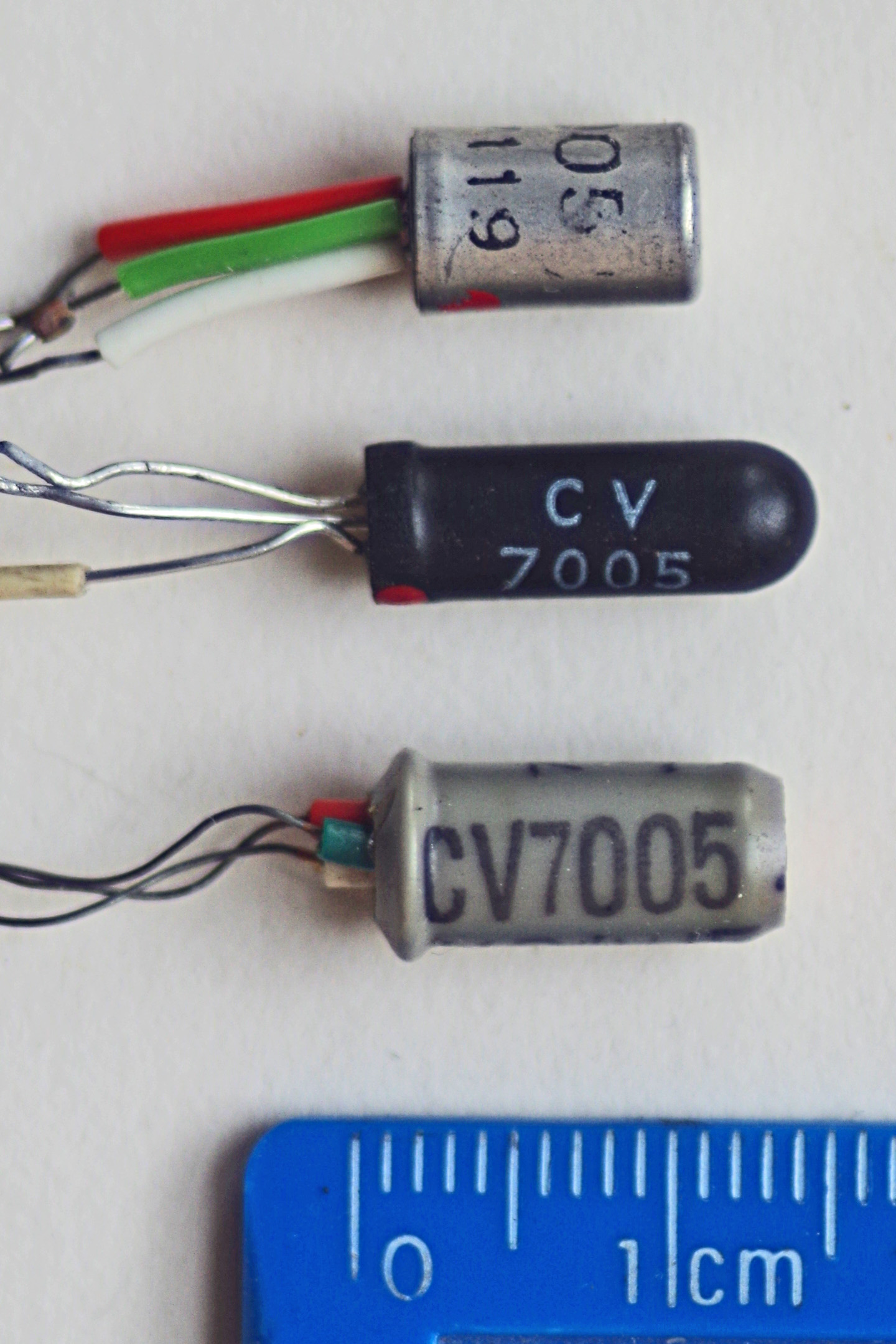
CV7006
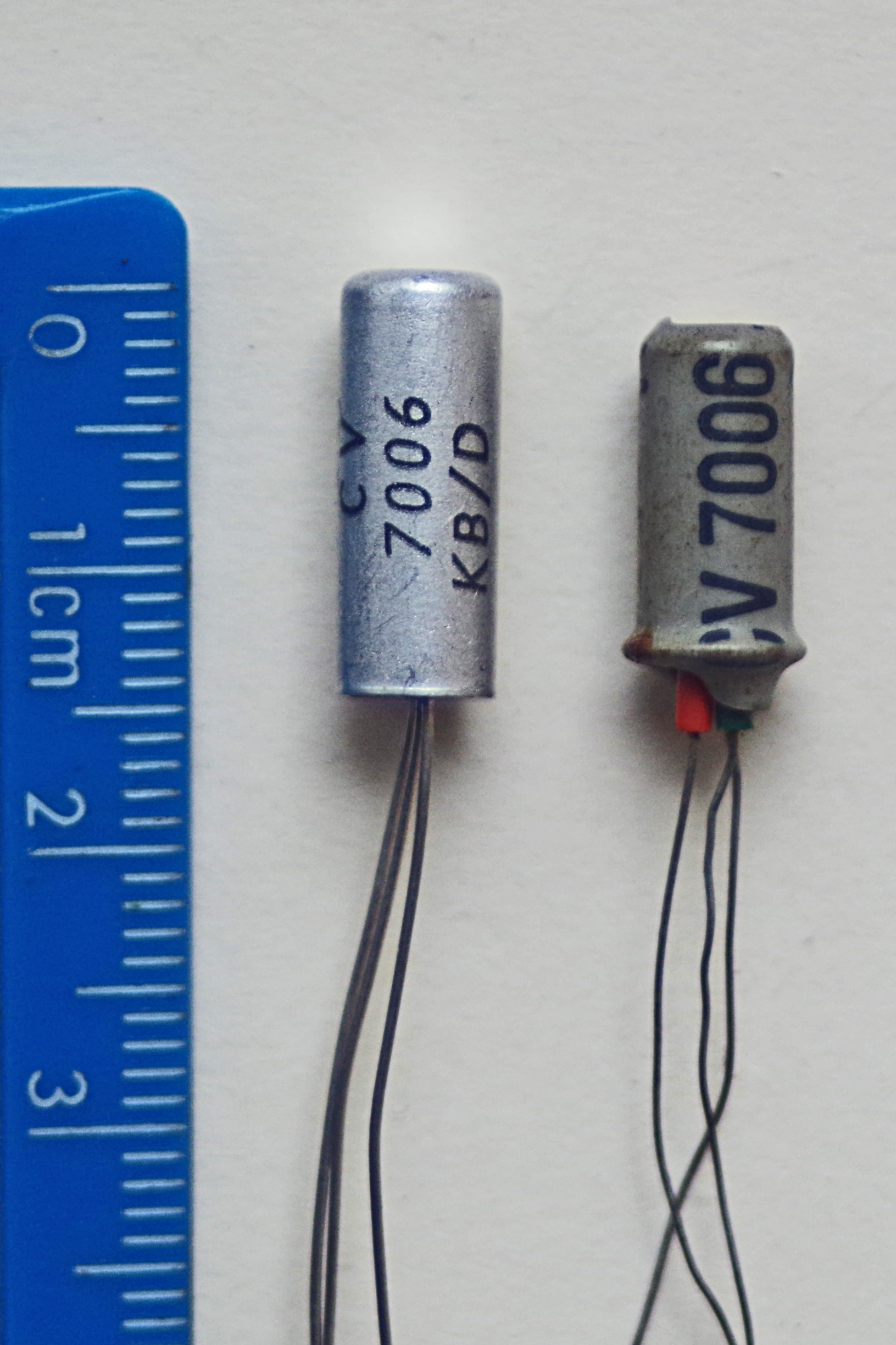
CV7007
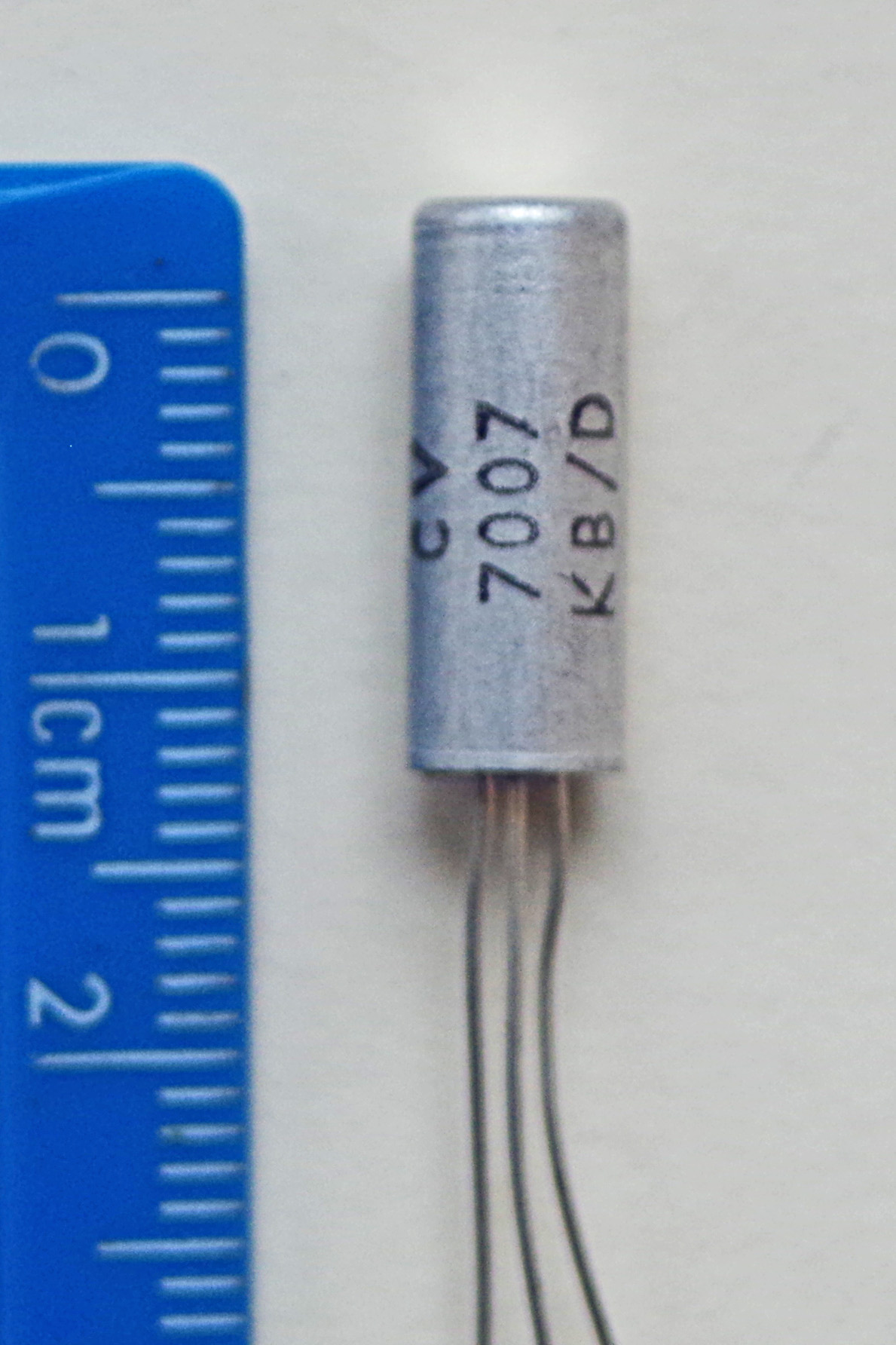
CV7008
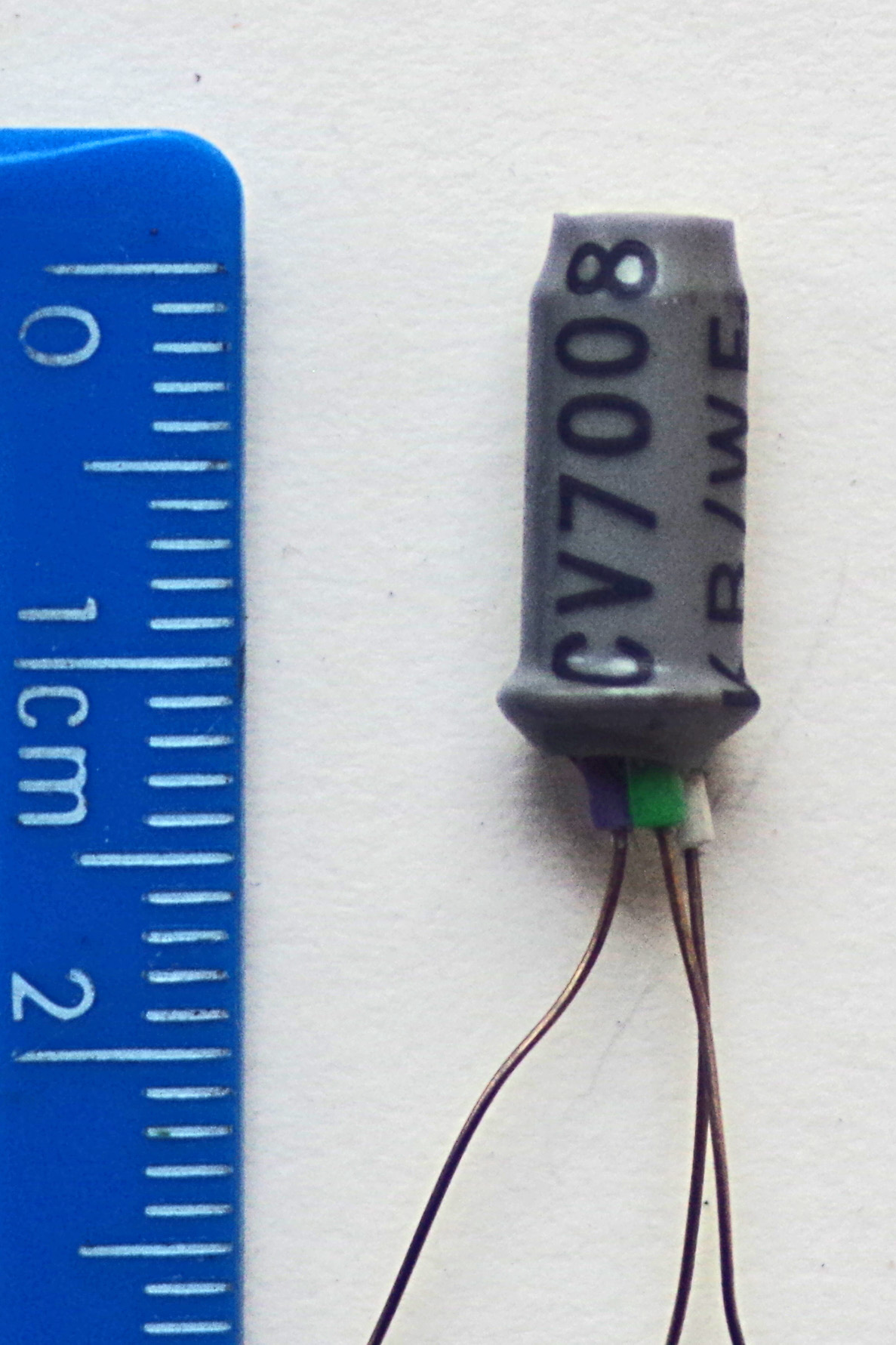
CV7009
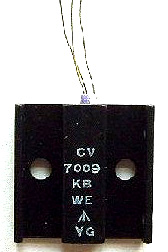
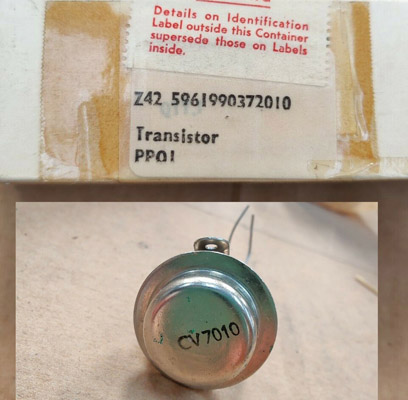
The CV7010 has prototype OC16. My example indeed has the unusual stud outline unique to OC16 and a few rare exceptions. It does not have the CV date code or a factory code.
I am seeking an example of CV7011 = Newmarket V30/30P.
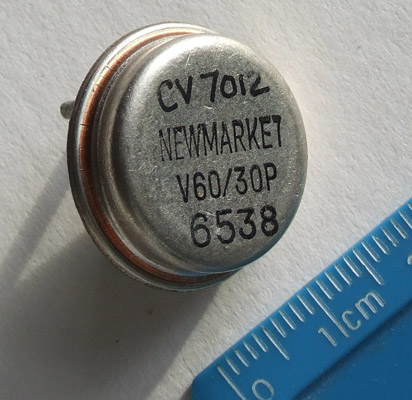
The CV7012 has prototype Newmarket V60/30P. My example indeed is printed V60/30P and has the CV number added by hand.
The group continues and eventually there is a series CV7080 - CV7086 that contains only power transistors:
CV7080
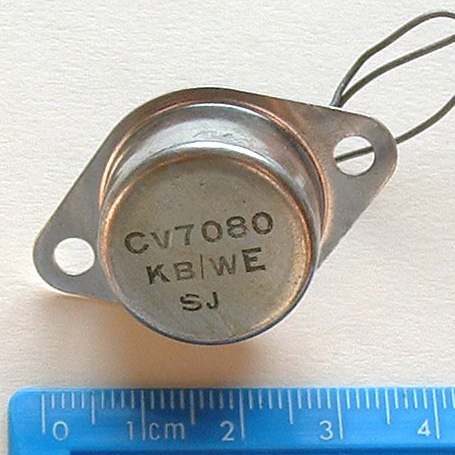
CV7081
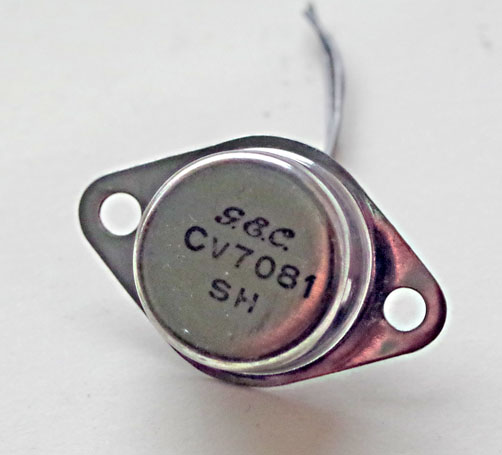
CV7082
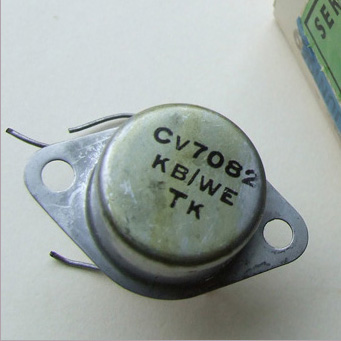
CV7083
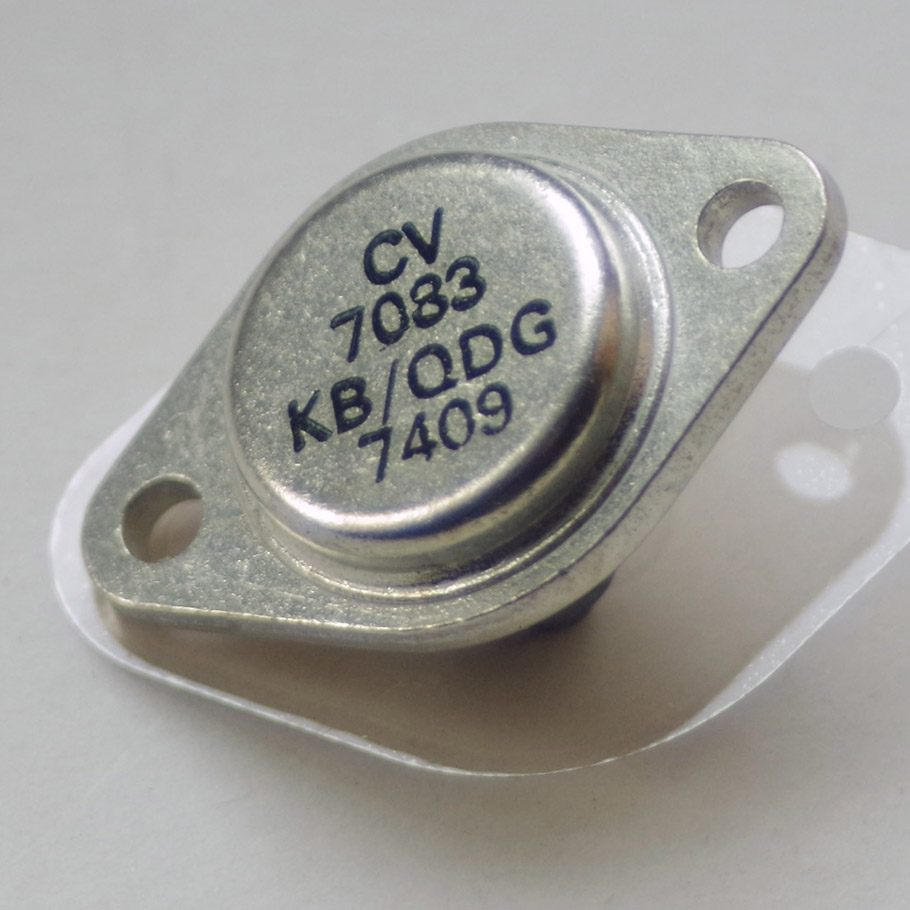
CV7084
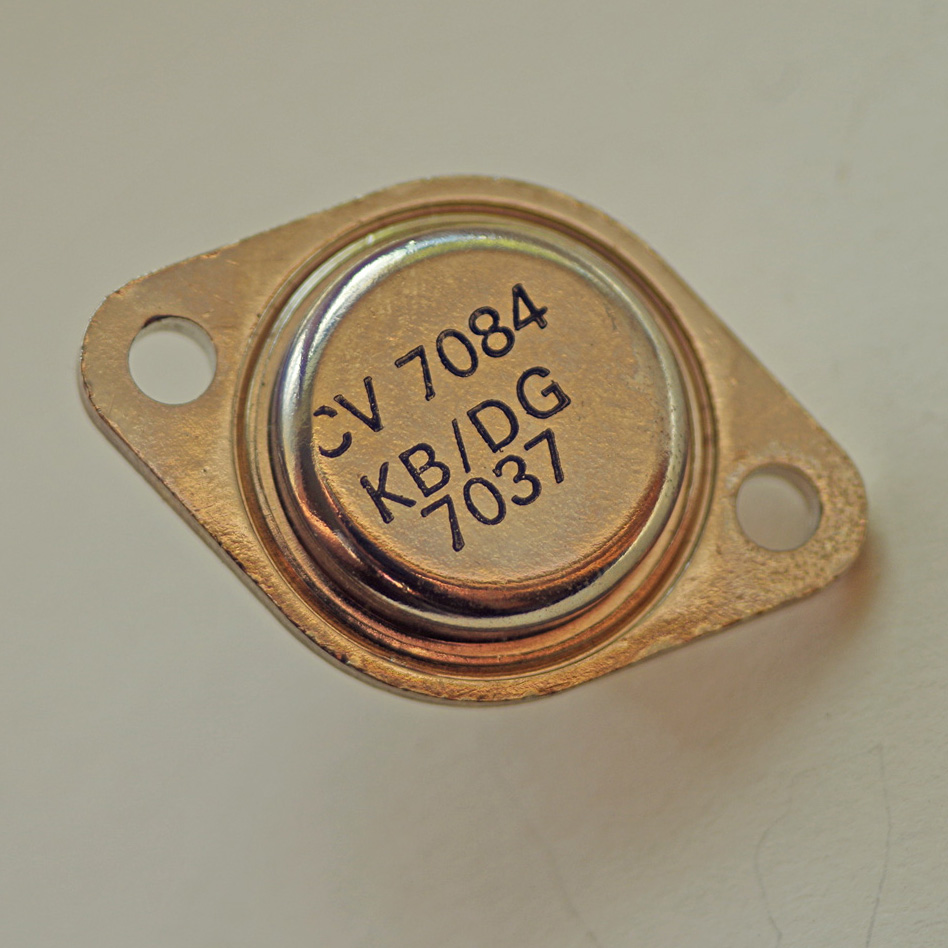
CV7085
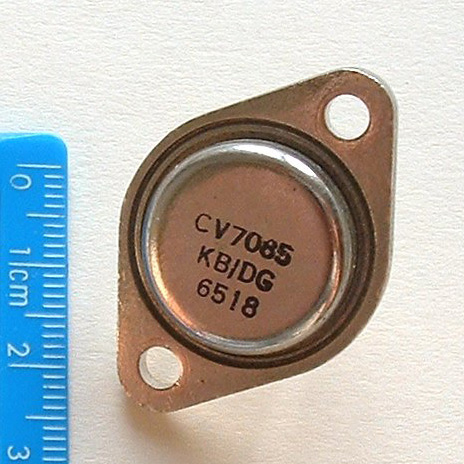
CV7086
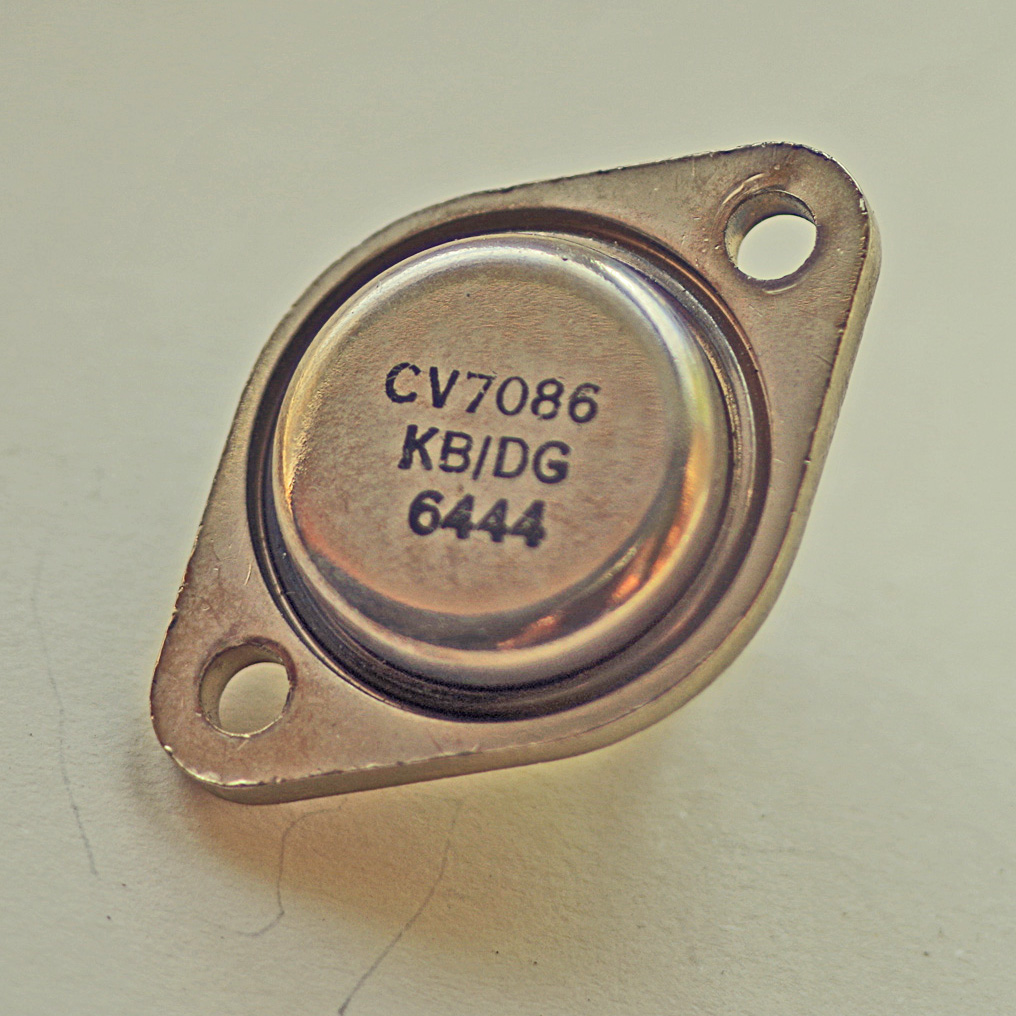
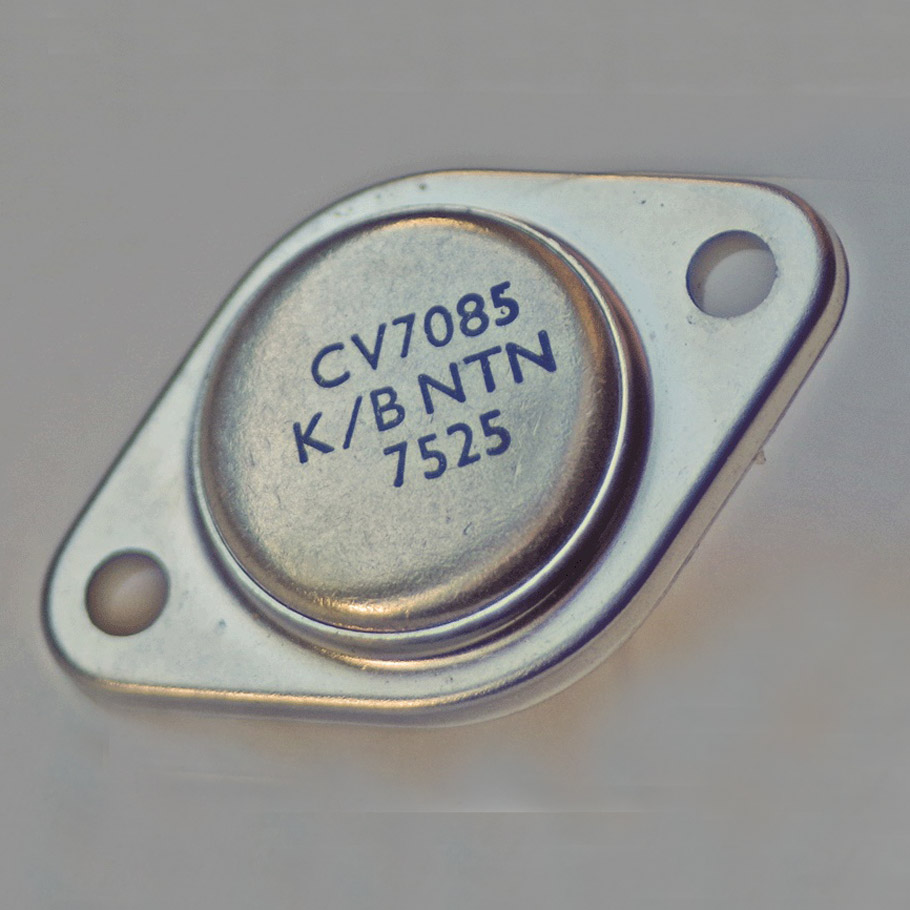
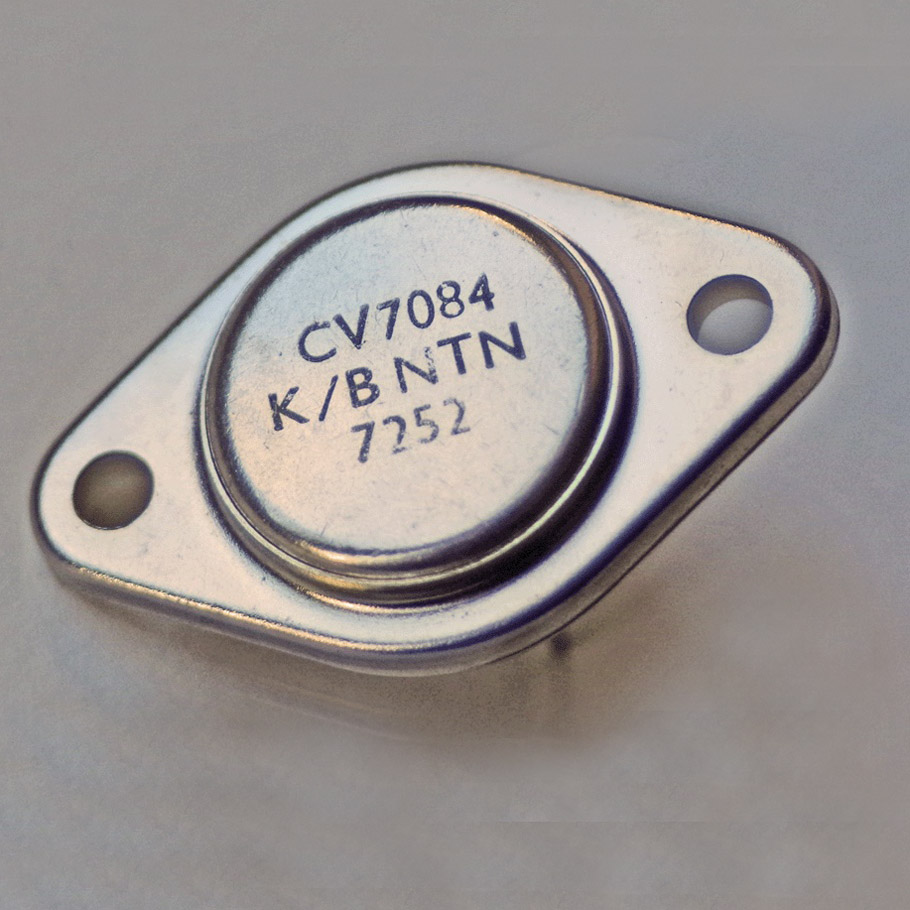
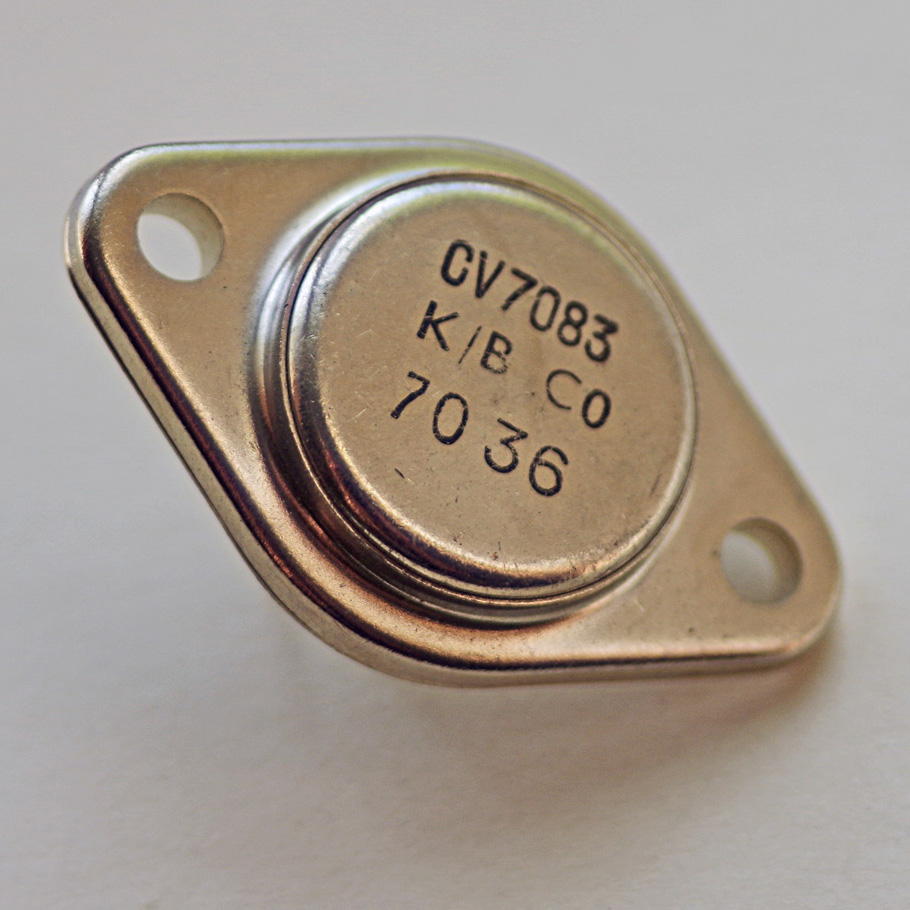
But here are CV7083, CV7084 and CV7085 made by Newmarket Transistors. Furthermore, only the CV7083 has the standard factory code of CO, the other two (with significantly later date codes) have a code of NTN. However their construction is unique to Newmarket. I am curious as to whether CV7086 was also made by them.
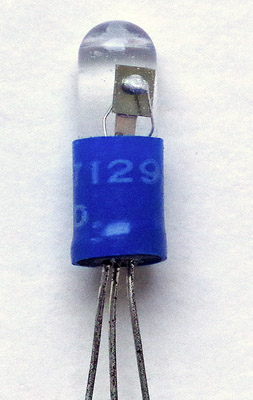
I am grateful to Bob, who sent me this CV7129 germanium phototransistor, with prototype the Philips/Mullard/Valvo OCP71. It is printed 'CV7129 D', which indicates that it was manufactured by Mullard, Mitcham, but it is missing the usual 'KB/' that indicates manufacture to specification and type approval. I don't think that is very significant as the type is in the 1963 Register.
There are few photoconductive semiconductors in the 1963 Register, although it does include quite a number of devices described as photocells, which I believe are caesium/gas photoemissive devices in a glass tube (without a heater). Those semiconductors that I can find are:
- CV5984 CdS photoconductive cell in a glass tube, with prototype ORP11.
- CV7129 phototransistor with prototype OCP71 as shown. (The only CV photodevice I have).
- CV8124 photodiode with prototype PG50A by STC.
- CV8349 phototransistor with prototype OCP71 and CV7129.
- CV8478 photodiode with prototypes 1S701 and 1N2175.
- CV9013 CdS photoconductive cell with prototype ORP12 by Mullard.
- CV9156 photodiode with prototype LS402 - apparently made by Texas Instruments.
- CV9445 photodiode with prototype SC/A19730 - source listed as 'CESD drawing' in Register.
- CV9889 photodiode with prototype OAP12 by Mullard.
- CV10981 phototransistor with prototype 2W2452 - this may be an error as I can't find such a device.
- CV11008 phototransistor with prototype BPX25 - a silicon NPN phototransistor made by ASM and others.
- CV11019 photodiode with prototype LS400 - apparently made by Texas Instruments.
A Web search for any of these turns up very little! Needless to say, I would be interested in examples of any of them.
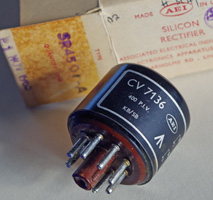
This CV7136 is an interesting device made by AEI. It plugs into a tube/valve base but contains four silicon diodes. Valve rectifiers are large and run very hot; using semiconductors instead has obvious benefits, although inside the box is a note with a stern warning about voltage surges at switch-on. AEI made three CV types: CV7135 with prototype SR4201-A, CV7136 with prototype SR4401-A, and CV7137 with prototype SR4501-A, however I don't think that they were a commercial success.
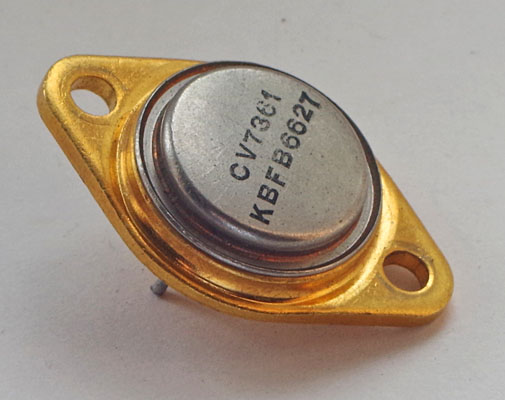
This CV7361 in a gold-plated TO-3 outline is marked KBFB for Standard Telephones & Cables, Footscray. Its protypes and possible substitutes are listed as the STC silicon NPN types BUY11 and TK203E. The outline is unusual for STC.
Other types in this block that I consider interesting and am seeking are:
- CV7184 = Semiconductors Ltd MA393A,
- CV7339 = Semiconductors Ltd SAC42B,
- CV7340 = Semiconductors Ltd SAC40
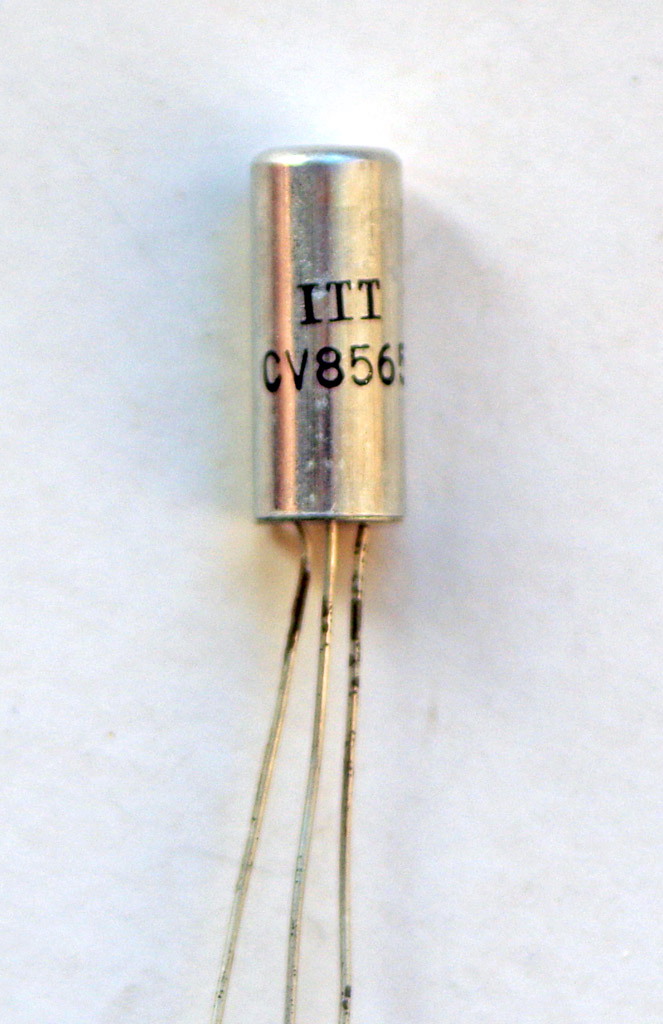
The CV8nnn part of the CV series includes many transistors and diodes, including germanium types, but I have only a few. The image shows a CV8565, which the Register shows as having prototype OC450K. That is an Intermetall silicon medium-power AF output type, but my example is marked ITT.
It is hard to know what CV8nnn types to list; these are the ones I consider most interesting and am seeking:
- CV8004 = Newmarket V30/20P
- CV8007 = Brush OC702K
- CV8124 = STC PG50A photodiode
- CV8276 = Newmarket V30/30P matched pair
- CV8349 = Mullard OCP71 phototransistor
- CV8358 = Semiconductors Ltd MA393
- CV8386 = Newmarket V15/20IP
- CV8442 = Semiconductors Ltd SAC40
- CV8582 = BTH GT42
- CV8680 = Semiconductors Ltd SA55
- CV8704 = STC JK10B tunnel diode
- CV8807 = Brush OC700
- CV8830 = Brush OC440
- CV8831 = Brush OC460
- CV8891 = Brush OC701
- CV8967 = Semiconductors Ltd MAS20
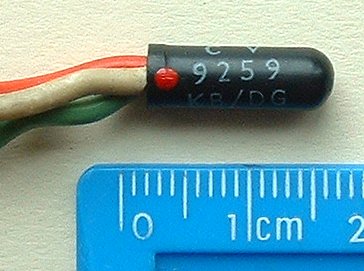
There are also a number of transistors and diodes in the CV9nnn part of the CV series, including germanium types. I have few of these. The image shows a CV9259, which the Register shows as a selected OC83, a germanium PNP medium-power switching transistor. However, I would expect the OC83 to use the metal-sleeved version of the SO-2 encapsulation, not the painted glass bulb that my CV9259 has.
Again it's impossible to know what to list here. The devices that most interest me and which I would most like to obtain are:
- CV9038 = TI(UK) 3S002
- CV9106 = BTH GT46
- CV9111 = BTH GT43
- CV9183 = STC TS13
- CV9220 = Semiconductors Ltd SA56
- CV9232 = BTH CG80-H
- CV9294 = STC XK575
- CV9376 = STC XK523
- CV9403 = Semiconductors Ltd SSA46
- CV9459 = Semiconductors Ltd SSA43
The Register continues to CV11261 (this may depend on the amendment number, and I have a copy with two handwritten types above CV12000), and there are germanium and interesting silicon types in this high-numbered section. It's a bit puzzling why some quite early germanium types appear here. These are just the transistors, there are germanium diodes too.
- CV10061 = Mullard OC141
- CV10064 = Mullard AAZ12
- CV10109 = STC ASY66
- CV10113 = Semiconductors Ltd MA393C
- CV10139 = Brush OC466
- CV10153 = Semiconductors Ltd SAC42A
- CV10160 = Mullard ADZ11
- CV10195 = Semiconductors Ltd SA52
- CV10202 = Newmarket NKT128
- CV10266 = Mullard OC20
- CV10273 = Mullard OC43
- CV10276 = Mullard AF118
- CV10283 = Mullard ADY26
- CV10292 = TI(UK) 2G303
- CV10376 = GEC GET880
- CV10394 = TI(UK) 2G382
- CV10397 = Semiconductors Ltd SAC44
- CV10579 = TI(UK) 2G309
- CV10718 = Mullard OC36
- CV10855 = Newmarket NKT228
- CV10885 = Mullard OC35 triplet
- CV10909 = Mullard ASZ15
- CV10971 = Newmarket NKT143
- CV11170 = Newmarket NKT216
- CV11175 = Newmarket NKT210
The 1963 CV Register also includes a few devices specified by the British General Post Office (GPO), as it was known in the 1960's. This series has the prefix PO and I believe that it has a relatively small number of members: only PO3 and PO4 can be found in the 1963 CV Register. The GPO was one of the bodies that could prepare the specification of a CV type, and I know that some other PO series members exist, up to perhaps PO50. (There are also CV types that are specified by the GPO but do not have an equivalent PO type). However I am not sure how many different PO types exist, if you have any documentation on the series, please
I am missing the PO2, if it exists. If you have any, please
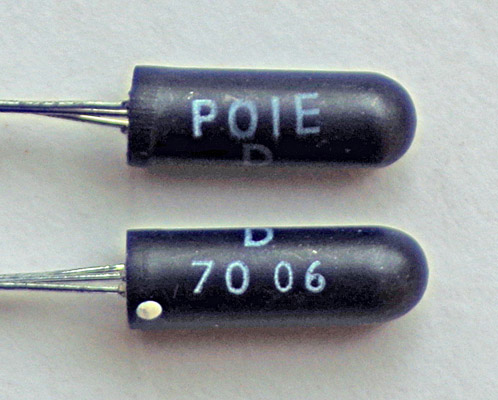
This PO1 type is not listed in the 1963 CV Register. The image shows examples with suffix E; I also have one with suffix F. They bear the factory code D for Mullard, Mitcham.
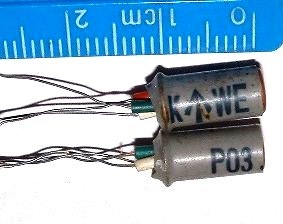
This PO3 type is listed in the 1963 CV Register as equivalent to CV7001 and GET103. It is marked K WE which means that it was manufactured to specification by GEC Wembley.
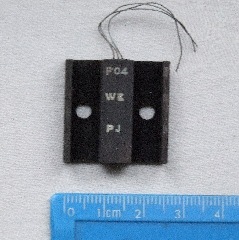
This PO4 type is listed in the 1963 CV Register as equivalent to CV7002 and GET116. It is marked with the factory code WE for GEC Wembley and the datecode PJ for September 1958.